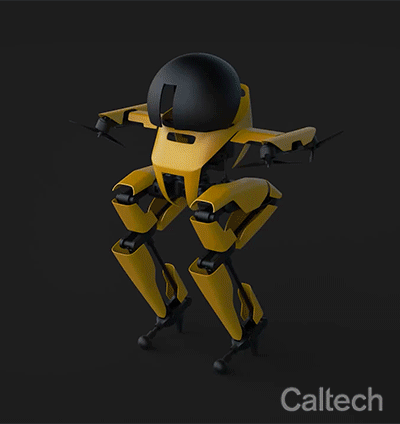Caltech’s innovative LEONARDO robot can Skateboard, Fly, and Walk on a Slackline.
LEO creates a new mode of movement that is halfway between walking and flying. Caltech researchers have created a bipedal robot that combines walking and flying to produce a new sort of locomotion that allows it to be extremely nimble and perform complex moves.
The recently designed LEONARDO (short for LEgs ONboARD drOne, or LEO for short) is a half-walking robot and part flying drone that can walk a slackline, hop, and even ride a skateboard. LEO is the first robot to accomplish precision balance control using multi-joint legs and propeller-based thrusters, developed by a team at Caltech’s Center for Autonomous Systems and Technologies (CAST).
A paper about the LEO robot was published online on October 6 and was featured on the October 2021 cover of Science Robotics.

[email-subscribers-form id=”1″]
We drew inspiration from nature. Think about the way birds are able to flap and hop to navigate telephone lines,” says Soon-Jo Chung, corresponding author and Bren Professor of Aerospace and Control and Dynamical Systems. “A complex yet intriguing behavior happens as birds move between walking and flying. We wanted to understand and learn from that.
“There is a similarity between how a human wearing a jet suit controls their legs and feet when landing or taking off and how LEO uses synchronized control of distributed propeller-based thrusters and leg joints,” Chung adds. “We wanted to study the interface of walking and flying from the dynamics and control standpoint.”
Bipedal robots can navigate complex real-world terrains by mimicking human movements such as hopping, jogging, and even ascending stairs, although they are hampered by rough terrain. Flying robots can easily handle difficult terrain by avoiding contact with the ground, but they have their own set of restrictions, including high energy consumption during flight and restricted payload capacity.

“Robots with a multimodal locomotion ability are able to move through challenging environments more efficiently than traditional robots by appropriately switching between their available means of movement. In particular, LEO aims to bridge the gap between the two disparate domains of aerial and bipedal locomotion that are not typically intertwined in existing robotic systems,” says Kyunam Kim, postdoctoral researcher at Caltech and co-lead author of the Science Robotics paper.
The researchers obtain the best of both worlds in terms of locomotion by employing a hybrid action that is somewhere between walking and flying. Because the thrusters are operated synchronously with leg joints, LEO’s lightweight legs relieve stress on the thrusters by sustaining the majority of the weight.
“Based on the types of obstacles it needs to traverse, LEO can choose to use either walking or flying, or blend the two as needed. In addition, LEO is capable of performing unusual locomotion maneuvers that even in humans require a mastery of balance, like walking on a slackline and skateboarding,”
says Patrick Spieler, co-lead author of the Science Robotics paper and a former member of Chung’s group who is currently with the Jet Propulsion Laboratory, which is managed by Caltech for NASA
LEO stands 2.5 feet tall and has two actuated joints on each leg, as well as four propeller thrusters positioned at an angle at the robot’s shoulders. When walking, a person adjusts the position and alignment of their legs to move their center of mass forward while maintaining body balance. LEO walks similarly: the propellers keep the robot upright while walking, and the leg actuators alter the position of the legs to move the robot’s center of mass forward using a synchronized walking and flying controller. In-flight, the robot flies like a drone, using only its propellers.
“Because of its propellers, you can poke or prod LEO with a lot of force without actually knocking the robot over,”
says Elena-Sorina Lupu (MS ’21), graduate student at Caltech and co-author of the Science Robotics paper.
The LEO project began in the summer of 2019 with three Caltech undergraduates who were members of the Institute’s Summer Undergraduate Research Fellowship (SURF) program and the authors of the Science Robotics publication.
The team then intends to increase LEO’s performance by developing a more stiff leg design capable of holding more of the robot’s weight and increasing the propeller thrust force. They also want to make LEO more autonomous so that it can figure out how much of its weight is supported by its legs and how much by its propellers when walking on rough terrain.

The researchers also intend to equip LEO with a newly designed deep neural network-based drone landing control algorithm. With a deeper grasp of the surroundings, LEO may decide for itself the optimal combination of walking, flying, or hybrid motion to utilize to get from one point to another, based on what is the safest and most energy-efficient.
“Right now, LEO uses propellers to balance during walking, which means it uses energy fairly inefficiently. We are planning to improve the leg design to make LEO walk and balance with minimal aid of propellers,”
says Lupu, who will continue working on LEO throughout her PhD program.
In the real world, the technology developed for LEO could aid the development of adaptive landing gear systems for aerial robots and other forms of flying vehicles, such as controlled leg joints. Future Mars rotorcraft could be built with legged landing gear, according to the scientists, so that the aerial robots’ body balance can be maintained while they land on sloped or uneven terrains, lowering the danger of failure in difficult landing conditions.
Alireza Ramezani, a former Caltech postdoctoral scholar who is now an assistant professor at Northeastern University, is a co-author on the work titled “A bipedal walking robot that can fly, slackline, and skateboard.” Caltech’s Gary Clinard Innovation Fund and the Center for Autonomous Systems and Technologies provided funding for this study.

